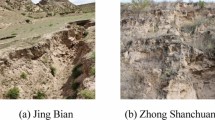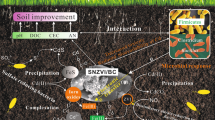Abstract
Contaminated clay soils pose problems to public health and the environment in several parts of the world. Very little is known about the transport of decontaminating agents used in remediation process under natural, undisturbed conditions. Nanomaterials, especially those made of nanoscale zero-valent iron (nZVI), have been most frequently used for remediation of contaminated soils because of their higher reactivity, lower toxicity, and lower cost than other metallic nanoparticles. Even though the nanoparticle size is smaller than soil pores, clogging may occur over time due to agglomeration of nanoparticles, which could reduce the soil’s natural permeability and thereby cause filtration of the nanoparticles. The use of a stabilizer in the nanoparticles can modify the reactivity but improves their mobility in the soil system. Thus, the objective of this work was to evaluate the hydraulic conductivity of residual clay soil under the injection of different types and concentrations of nZVI with and without surfactant stabilizer (NANOFER 25, NANOFER 25S, and NANOFER STAR in powder at 1 g/L, 4 g/L, 7 g/L, and 10 g/L concentrations), and to model transport of these nZVI suspensions in this soil system. Undisturbed cylindrical soil samples collected from the field were used, and hydraulic conductivity tests were performed using a column apparatus. The results showed that the presence of the stabilizer in the nZVI influenced the nanoparticles’ mobility. The nZVI concentrations of 1 and 4 g/L did not affect the natural soil hydraulic conductivity. However, higher concentrations reduced the hydraulic conductivity value, which retarded the migration of nZVI as reflected in the value of filtration parameter.








Similar content being viewed by others
References
ASTM (1995) American Society for Testing and Materials D4874: standard test method for leaching solid material in a column apparatus. ASTM, Philadelphia
ASTM (2017) American Society for Testing and Materials D4691: standard practice for measuring elements in water by flame atomic absorption spectrophotometry. ASTM International, West Conshohocken
Bradford SA, Simunek J, Bettahar M, Van Genuchten MT, Yates SR (2006) Significance of straining in colloid deposition: evidence and implications. Water Resour Res 42(12). https://doi.org/10.1029/2005WR004791
Cai C, Zhao M, Yu Z, Rong H, Zhang C (2019) Utilization of nanomaterials for in-situ remediation of heavy metal(loid) contaminated sediments: a review. Sci Total Environ 662:205–217. https://doi.org/10.1016/j.scitotenv.2019.01.180
Cecchin I, Reddy KR, Thomé A, Tessaro EF, Schnaid F (2017) Nanobioremediation: integration of nanoparticles and bioremediation for sustainable remediation of chlorinated organic contaminants in soils. Int Biodeterior Biodegradation 119:419–428. https://doi.org/10.1016/j.ibiod.2016.09.027
Crane RA, Scott TB (2012) Nanoscale zero-valent iron: future prospects for an emerging water treatment technology. J Hazard Mater 211–212:112–125. https://doi.org/10.1016/j.jhazmat.2011.11.073
Dalla Vecchia E, Luna M, Sethi R (2009) Transport in porous media of highly concentrated iron micro- and nanoparticles in the presence of xanthan gum. Environ Sci Technol 43(23):8942–8947. https://doi.org/10.1021/es901897d
Darko-Kagya K, Khodadoust AP, Reddy KR (2010) Reactivity of lactate-modified nanoscale iron particles with 2,4-dinitrotoluene in soils. J Hazard Mater 182:177–183. https://doi.org/10.1016/j.jhazmat.2010.06.012
Du Q, Zhang S, Pan B, Lv L, Zhang W, Zhang Q (2013) Bifunctional resin–ZVI composites for effective removal of arsenite through simultaneous adsorption and oxidation. Water Res 47:6064–6074. https://doi.org/10.1016/j.watres.2013.07.020
Gil-Díaz M, González A, Alonso J, Lobo MC (2016) Evaluation of the stability of a nanoremediation strategy using barley plants. J Environ Manag 165:150–158. https://doi.org/10.1016/j.jenvman.2015.09.032
He X, Zhong P, Qiu X (2018) Remediation of hexavalent chromium in contaminated soil by Fe(II)-Al layered double hydroxide. Chemosphere 210:1157–1166. https://doi.org/10.1016/j.chemosphere.2018.07.048
Hosseini SM, Tosco T (2013) Transport and retention of high concentrated nano-Fe/Cu particles through highly flow-rated packed sand column. Water Res 47:326–338. https://doi.org/10.1016/j.watres.2012.10.002
Hu N, Li Z, Huang P, Tao C (2006) Distribution and mobility of metals in agricultural soils near a copper smelter in South China. Environ Geochem Health 28:19–26. https://doi.org/10.1007/s10653-005-9007-z
Huang D, Hu Z, Peng Z, Zeng G, Chen G, Zhang C, Cheng M, Wan J, Wang X, Qin X (2018) Cadmium immobilization in river sediment using stabilized nanoscale zero-valent iron with enhanced transport by polysaccharide coating. J Environ Manag 210:191–200. https://doi.org/10.1016/j.jenvman.2018.01.001
Jiang D, Guangming Z, Danlian H, Ming C, Chen Z, Chao H, Jia W (2018) Remediation of contaminated soils by enhanced nanoscale zero valent iron. Environ Res 163:217–227. https://doi.org/10.1016/j.envres.2018.01.030
Karn B, Kuiken T, Otto M (2009) Nanotechnology and in situ remediation: a review of the benefits and potential risks. Environ Health Perspect 117(12):1813–1831. https://doi.org/10.1289/ehp.0900793
Klaine SJ, Alvarez PJJ, Batley GE, Fernandes TE, Handy RD, Lyon DY, Mahendra S, Mclaughlin MJ, Lead JR (2008) Nanoparticles in the environment: behavior, fate, bioavailability, and effects. Environ Toxicol Chem 27:1825–1851. https://doi.org/10.1897/08-090.1
Lefevre E, Bossa N, Wiesner M, Gunsch C (2016) A review of the environmental implications of in situ remediation by nanoscale zero valent iron (nZVI): behavior, transport and impacts on microbial communities. Sci Total Environ 15:889–901. https://doi.org/10.1016/j.scitotenv.2016.02.003
Liu L, Wei L, Weiping S, Mingxin G (2018) Remediation techniques for heavy metal-contaminated soils: principles and applicability. Sci Total Environ 633:206–219. https://doi.org/10.1016/j.scitotenv.2018.03.161
Mueller NC, Braun J, Bruns J, Cerník M, Rissing P, Rickerby D, Nowack B (2012) Application of nanoscale zero valent iron (nZVI) for groundwater remediation in Europe. Environ Sci Pol 19:550–558. https://doi.org/10.1007/s11356-011-0576-3
Nanoiron s.r.o (2018) Nanoiron, future technology. https://nanoiron.cz/en/. Accessed 25 July 2018
Nanorem (2018) Nanotechnological remediation processes from lab scale to end user applications for the restoration of a clean environment. http://www.nanorem.eu/index.aspx. Accessed 31 June 2018
Petosa R, Jaisi DP, Quevedo IR, Elimelech M, Tufenkji N (2010) Aggregation and deposition of engineered nanomaterials in aquatic environments: role of physicochemical interactions. Environ Sci Technol 44:6532–6549. https://doi.org/10.1021/es100598h
Phenrat T, Kim H-J, Fagerlund F, Illangasekare T, Lowry GV, Tilton RD (2009) Particle size distribution, concentration, and magnetic attraction affect transport of polymer-modified Fe-0 nanoparticles in sand columns. Environ Sci Technol 43:5079–5085. https://doi.org/10.1021/es900171v
Phenrat T, Kim H-J, Fagerlund F, Illangasekare T, Lowry GV (2010a) Empirical correlations to estimate agglomerate size and deposition during injection of a polyelectrolyte-modified Fe0 nanoparticle at high particle concentration in saturated sand. J Contam Hydrol 118:152–164. https://doi.org/10.1016/j.jconhyd.2010.09.002
Phenrat T, Cihan A, Kim H-J, Mital M, Illangasekare T, Lowry GV (2010b) Transport and deposition of polymer-modified Fe0 nanoparticles in 2-D heterogeneous porous media. Effects of particle concentration, Fe0 content, and coatings. Environ Sci Technol 44:9086–9093. https://doi.org/10.1021/es102398e
Reddi LN, Ming X, Hajra MG, Lee IM (2000) Permeability reduction of soil filters due to physical clogging. J Geotech Geoenviron 126(3):236–246. https://doi.org/10.1061/(ASCE)1090-0241(2000)126:3(236
Reddy KR (2010) Nanotechnology for site remediation: dehalogenation of organic pollutants in soils and groundwater by nanoscale iron particles. In: Proceedings of the 6th International Congress on Environmental Geotecnics. New Delhi, India. Vol. 1:163–180
Reddy KR, Darko-Kagya K, Cameselle C (2011) Electrokinetic-enhanced transport of lactate-modified nanoscale iron particles for degradation of dinitrotoluene in clayey soils. Sep Purif Technol 79:230–237. https://doi.org/10.1016/j.seppur.2011.01.033
Reddy KR, Darnault C, Darko-Kagya K (2014) Transport of lactate-modified nanoscale iron particles in porous media. J Geotech Geoenviron Eng 140(2). https://doi.org/10.1061/(ASCE)GT.1943-5606.0001015
Saleh N, Sirk K, Liu Y, Phenrat T, Dufour B, Matyjaszewski K, Tilton RD, Lowry GV (2007) Surface modifications enhance nanoiron transport and NAPL targeting in saturated porous media. Environ Eng Sci 24:45–57. https://doi.org/10.1089/ees.2007.24.45
Schrick B, Blough JL, Jones AD, Mallouk TE (2002) Hydro dechlorination of trichloroethylene to hydrocarbons using bimetallic nickel–iron nanoparticles. Chem Mater 14:5140–5147. https://doi.org/10.1021/cm020737i
Song Y, Fang G, Zhu C, Zhu F, Wu S, Chen N, Wu T, Wang Y, Gao J, Zhou D (2019) Zero-valent iron activated persulfate remediation of polycyclic aromatic hydrocarbon-contaminated soils: an in situ pilot-scale study. Chem Eng J 355:65–75. https://doi.org/10.1016/j.cej.2018.08.126
Streck EV, Kampf N, Dalmolin RSD, Klamt E, Nascimento PC, Schneider P, Giasson E, Pinto LFS (2008) Rio Grande do Sul soils. 2nd edn. Porto Alegre: UFRGS: EMATER/RS-ASCAR, Brazil (In Portuguese)
Sun Y-P, Li X-Q, Cao J, Zhang W-X, Wang HP (2006) Characterization of zerovalent iron nanoparticles. Adv Colloid Interf Sci 120:47–56. https://doi.org/10.1016/j.cis.2006.03.001
Thomé A, Reddy KR, Reginatto C, Cecchin I (2015) Review of nanotechnology for soil and groundwater remediation: Brazilian perspectives. Water Air Soil Pollut 226:2–20. https://doi.org/10.1007/s11270-014-2243-z
Tosco T, Sethi R (2010) Transport of non-Newtonian suspensions of highly concentrated micro- and nanoscale iron particles in porous media: a modeling approach. Environ Sci Technol 44:9062–9068. https://doi.org/10.1021/es100868n
Tosco T, Papini MP, Viggi CC, Sethi R (2014) Nanoscale zerovalent iron particles for groundwater remediation: a review. J Clean Prod 77:10–21. https://doi.org/10.1016/j.jclepro.2013.12.026
USEPA (2014) U.S. Environmental Protection Agency. Nanotechnology: applications for environmental remediation. http://www.cluin.org/techfocus/default.focus/sec/Nanotechnology:_Applications_for_Environmental_Remediation/cat/Application/#3. Accessed 6 Dec 2014
Wang M, Gao B, Tang D (2016) Review of key factors controlling engineered nanoparticle transport in porous media. J Hazard Mater 318:233–246. https://doi.org/10.1016/j.jhazmat.2016.06.065
Yan W, Lien H-L, Koel BE, Zhang W-X (2013) Iron nanoparticles for environmental clean-up: recent developments and future outlook. Environ Sci Process Impacts 15:63–77. https://doi.org/10.1039/C2EM30691C
Zhang W-X (2003) Nanoscale iron particles for environmental remediation: an overview. J Nanopart Res 5:323–332. https://doi.org/10.1023/A:1025520116015
Zhang Y, Li YM, Zheng XM (2011) Removal of atrazine by nanoscale zero valent iron supported on organobentonite. Sci Total Environ 409:625–630. https://doi.org/10.1016/j.scitotenv.2010.10.015
Zhang R, Li J, Liu C, Shen J, Sun X, Han W, Wang L (2013) Reduction of nitrobenzene using nanoscale zero-valent iron confined in channels of ordered mesoporous silica. Colloids Surf A Physicochem Eng Asp 425:108–114. https://doi.org/10.1016/j.colsurfa.2013.02.040
Zhang M, Feng H, Dongye Z, Xiaodi H (2017) Transport of stabilized iron nanoparticles in porous media: effects of surface and solution chemistry and role of adsorption. J Hazard Mater 322:284–291. https://doi.org/10.1016/j.jhazmat.2015.12.071
Acknowledgments
The authors appreciate the support of the CNPQ, FAPERGS, and CAPES and the research group on Environmental Geotechnics UPF/UFRGS.
Author information
Authors and Affiliations
Corresponding author
Additional information
Responsible editor: Marcus Schulz
Publisher’s note
Springer Nature remains neutral with regard to jurisdictional claims in published maps and institutional affiliations.
Rights and permissions
About this article
Cite this article
Reginatto, C., Cecchin, I., Salvagni Heineck, K. et al. Influence of nanoscale zero-valent iron on hydraulic conductivity of a residual clayey soil and modeling of the filtration parameter. Environ Sci Pollut Res 27, 9288–9296 (2020). https://doi.org/10.1007/s11356-019-07197-1
Received:
Accepted:
Published:
Issue Date:
DOI: https://doi.org/10.1007/s11356-019-07197-1




